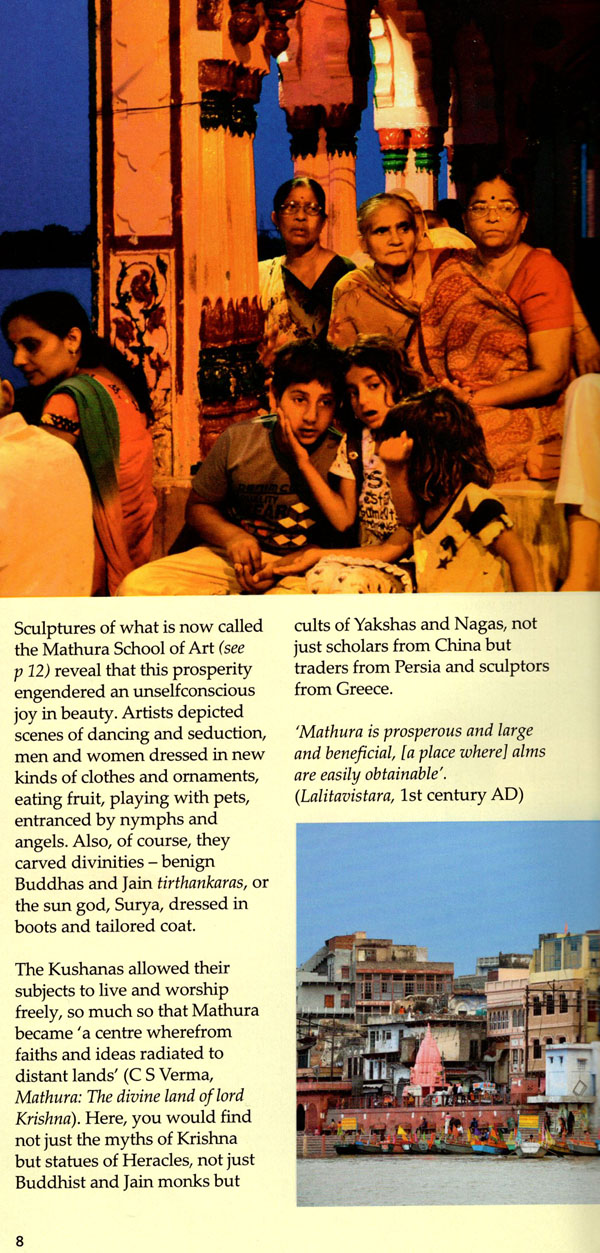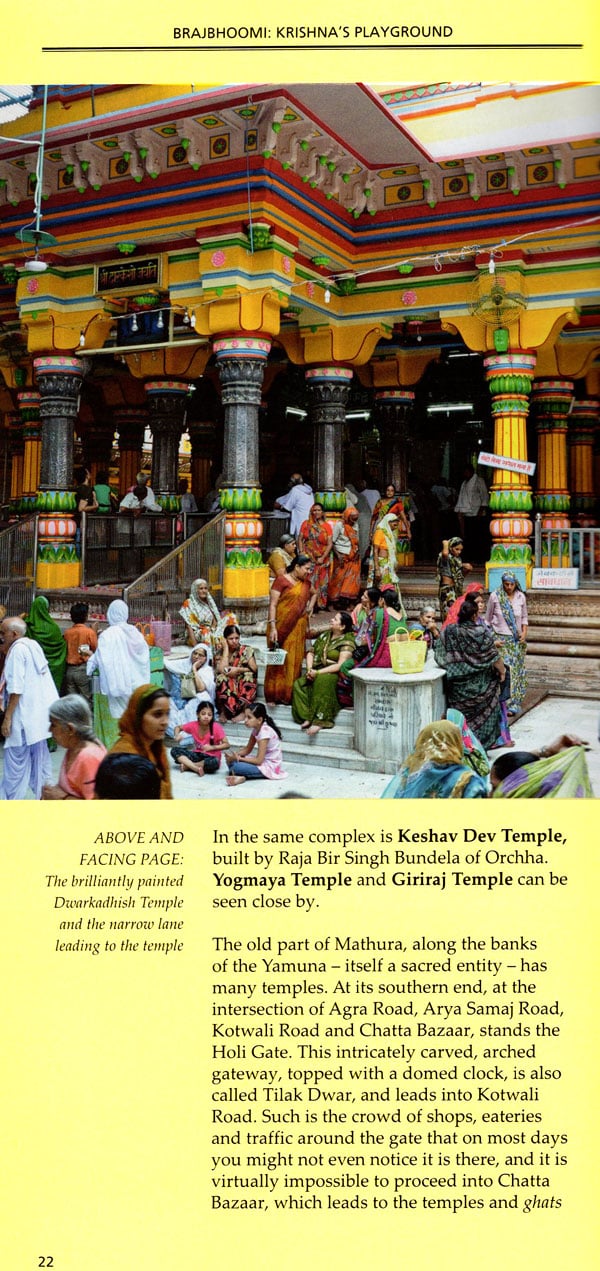
Brajbhoomi Krishna's Playground (Travel Guide)
Book Specification
| Item Code: | NAO879 |
| Author: | Swati Mitra |
| Publisher: | Eicher Goodearth Pvt. Ltd. |
| Language: | English |
| Edition: | 2013 |
| ISBN: | 9789380262680 |
| Pages: | 96 (Throughout Color Illustrations) |
| Cover: | Paperback |
| Other Details | 9.0 inch X 5.0 inch |
| Weight | 170 gm |
Book Description
With his love for freshly –churned butter and playing pranks on cowgirls, his melodious flute and demon- defying strength, his mischeif and charm, Krishna has long provided a unique solace to his devotees, and a vast and intricate mythology to scholars, pilgrims and travellers alike. In Brajbhoomi: Krishna's Playground we take the reader through the forests, gardens and riverbanks of Krishna's childhood, the temples and pilgrimage circuits that today commemorate his Idea.
From busting Mathura with its narrow lanes and ancient past, to the more pastoral enviroms of Vrindavan, where Krishna grew up, the guidebook takes the traveller to less known destinations such as Govardhan and Gokul, Nandgaon, Mahavan, Baldeo and Barsana.
This Travel Guide also includes an introduction to the stories and paintings, poetry and song inspired by Krishna, as well as the main Festivals of Braj.
Besides, it has sections on Mathura Schools of Art, among the oldest and most celebrated in the world; the sweet –sounding Braj bhasa of the region; and its cusine, with the delicious milk – based sweets that are its hallmark.
With over 130 especially –commisioned photographs, reproductions of both popular and an up –to –date practical information section, this book is an invaluable companion for the spiritual visitors, the intrepid tourist and the armchair traveller.
At a time when manu of the world's greatest empires were still undreamt of, when most of its religious and philosophies were yet unthought, and its epics and myhts were still being polished and refined, there glimmered across the globe a few, faraway cities, animated by a seemingly miraculous drive towards commerce and art, wealth and creation. One of these was ancient Rome; another was Mathura.
One of the first melting pots of the world, Mathura is today in the heart of Brajbhoomi the playground of Lord Krishna. Brajbhoomi includes the nearby villages of Vrindavan, Gokul, Goverdhan, Barsana and Nandgaon, and charts the life of the young Krishna. Glimpse of Mathura, however, first appear in ancient Sanskrit Vedic literature, in the epics and Puranas, and early Buddhist and Jain texts. From some of these it may be surmised that this land was once green with the Madhuvana forest, from which the city got its name. Vedic texts do not mention Mathura itself, but talk of its people, the Yadus (or Yadavas); while various Puranas identify the Surasena, descendants of the mythical hero Rama's brother Shatrughana, as ruler of Mathura.
Archaeological readings, meanwhile, suggest that what began as a small village on the fertile banks of the Yamuna circa 600 BC grew into a city of about 4 sq kms in the next three hundred years. The Harivamsa Purana, dated between the 2nd century BC and the well –established, well –democrated and cosmopolitan city of Mathura... with its high defences and moats'.
Ideallly located on both the Uttarapatha and Dakshinapatha, ancient trade routes of the Indian subcontinent, Mathura's growth received acclerated momentum under the Kushana kings, who made it their capital in the east. At its peak, the mightly Kushana empire had four capitals –the other three being Bagram, Peshawar and Taxila –and covered 3.8 million square kilometers. Their trade links stretched from China to Rome; their cities were veritable whirlpools of cultures and arts; and Mathura experienced a dizzying prosperity.
Yamuna
Originating from the Yamunotri Galcier high in the Himalayas., the Yamuna river gives Mathura fertile fields and navigable waters. It is best known, however, for its inextricable link to the mythology of Brajbhoomi, being associated with Krishna's birth, and his many childhood adventures.
Daughter of Surya, the sun god, and twin sister of Yama, the god of death, the Yamuna is usually portyard as a goddess of Krishna. In fact, in the temples of Brajboomi, the river discards her traditional mount, the slow tortoise, such is her restlessness for Krishna. Bathing in her waters is believed to free one from the sorrows of the world and the torments of death.
Sculptures of what is now called the Mathura School of Art (see p 12) reveal in that this prosperity engendered an unselfconsious joy in beauty. Artist depicted scenes of dancing and seduction men and women dressed in new kinds of clothes and ornaments, eating fruit, playing with pets, entranced by nuymphs and angels, Also of course, they carved divinities –bengin Buddhas and Jain tirthankaras, or the sun god, Surya, dressed in boots and tailored coat.
The Kushnanas allowed their subjects to live and worship freely, so much so that Mathura became' a centre wherefrom faiths and ideas radiated to distant lands' (CS Verma, Mathura: The divine land of lord Krishna). Here, you would find not just the myths of Krishna but status of Heracles, not just Buddhist and Jain monks but the effects of Kushana rule were bolstered by the patronage of the Gupta rulers who followed (c. 320 -550 A.D). The end of the 5th century, however, brought the Hunas, who effectively ended the Gupta dynasty. In the process, Mathura lost a great deal of its art and riches, though certainly not all, for the 7th –century Chinese scholar Hieum Tsang, found monasterires and monks still settled here, in a land that was 'fertile and yellow in colour' with people of high intellinet, honest and of good character.'
Thereafter, Mathura slipped out of history for a few centuries, returning only after another invasion –by Mahmud of Ghazani, in 1017. An account of the Sacking of Mathura, penned by Ghazni's secretary, Al –Utbi, reveals that the city might have surrendered its strategic significance to Delhi, but it remained properous.
The town was constructed of solid stone... In the middle of the lcity was a temple, larger and finer than the rest, to which neither painting nor description could do justice. The Sultan thus wrote respecting it: 'If any one wished to contract a building equal to it, he would not be able to do so without expending a hundred million dinars, and the work would occupy two hundred years, even through the most able and experienced workmen were employed.'
So impressed was Ghazni by the temple that though he ordered the city's idols looted –many were made of solid gold, studded with gems –he may not have had buildings destroyed. Instead, he copied the style to build a mosque in his own capital.
Later dynasties that ruled northern India –most notably the Mughals –had conflicting polices regarding Mathura, Emperor Akbar was well –disposed towards the city,even experiencing spiritual epiphany in neighbouring Vrindavan; his great –grandson, Aurangjeb however, was distinctly hostile, it was in these years,too, beginning in the 16th century, that this region, the Brajbhoomi, acquired the distinctly Vaishanva character that defines it today.
| Content | Page No. |
| Introduction | 4 |
| Exploring Brajbhoomi | 17 |
| Mathura | 18 |
| Vrindavan | 30 |
| Gokul | 56 |
| Mahavan | 60 |
| Baldeo | 61 |
| Goverdhan | 62 |
| Barsana | 68 |
| Nandgaon | 72 |
| Braj Chaurasi Kos Yatra | 76 |
| Festivals | 78 |
| Cuisine | 84 |
| Krishna in the Arts | 88 |
| Practical Information | 92 |









